Eberhard Scafograf 300 – A Hands-On Review
This past March at Baselworld, Blaise, Teun and I had the opportunity to sit down with Eberhard & Co and were introduced to a watch that really hits the sweet spot of our readership: the Scafograf 300. In fact, Teun published an overview of the watch based upon our brief session with the company during the show and people certainly showed interest. Since that time, though, we’ve kept in touch with the brand in order to get our hands on a watch for a more thorough review and a couple weeks ago, Eberhard was finally ready!

Eberhard Scafograf 300 (photo credit: casowatches.com)
Eberhard History
If you don’t know much about Eberhard & Co, don’t feel too embarrassed as I really hadn’t looked into the brand seriously until a couple of years ago. Eberhard is a longstanding name in Swiss watchmaking and was founded in 1887 in La Chaux de Fonds. My introduction to the brand was really via their vintage chronographs – notably the Extra Fort and the lovely (expensive and rare) 1960’s Contograf. However, like so many companies in the 1950’s and 60’s, Eberhard also turned their attention to dive watches and in 1959, the first Scafograf was introduced. Multiple generations were produced and, significantly, a version was introduced in 1966 as the Scafograf 300. The watch was quite similar in design to the contemporary Seamaster 300 with its lyre lugs and even had a case made by HF (Huguenin Freres) – the same company that made cases for the Omega. Eberhard’s new version of the 300, roughly 50 years after the introduction of the original, contains some similar design cues, but as you’ll see, it’s evolutionary instead of being an exact copy.
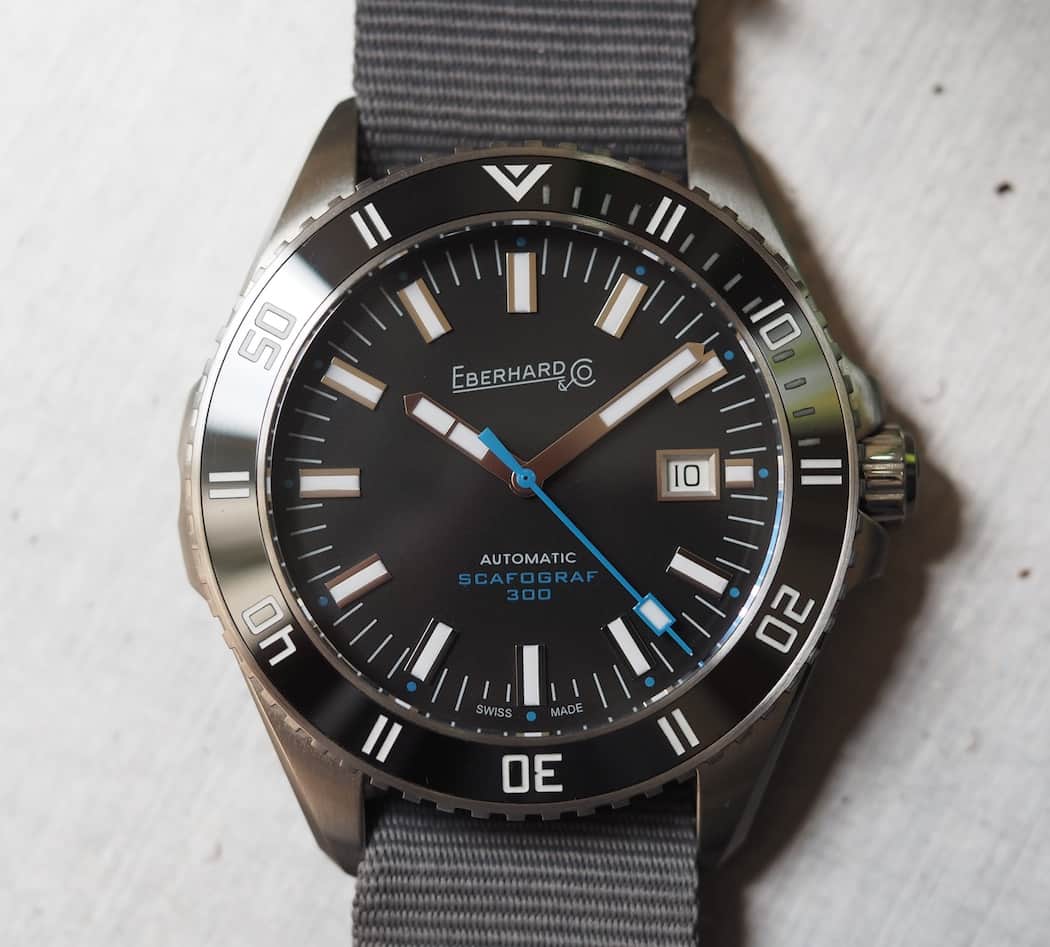
Head-on, it’s hard to deny the good looks of the Scafograf 300
Scafograf 300 Particulars
Eberhard introduced the new Scafograf 300 in three different color combinations and on either rubber or a stainless steel bracelet. In addition to the blue version you see here, editions are available in yellow and white. The watch is stainless steel, 43mm in diameter and features a relatively uncommon 21mm lug width. It contains a ceramic, unidirectional 120-click diver’s bezel, screw down case back and crown, helium valve (more on this later) and 300m of water resistance. Naturally, the crystal is anti-reflective sapphire and, in this case, the strap features a pin buckle. Finally, beating away inside is the ETA 2824-2, which hacks and features a date function.
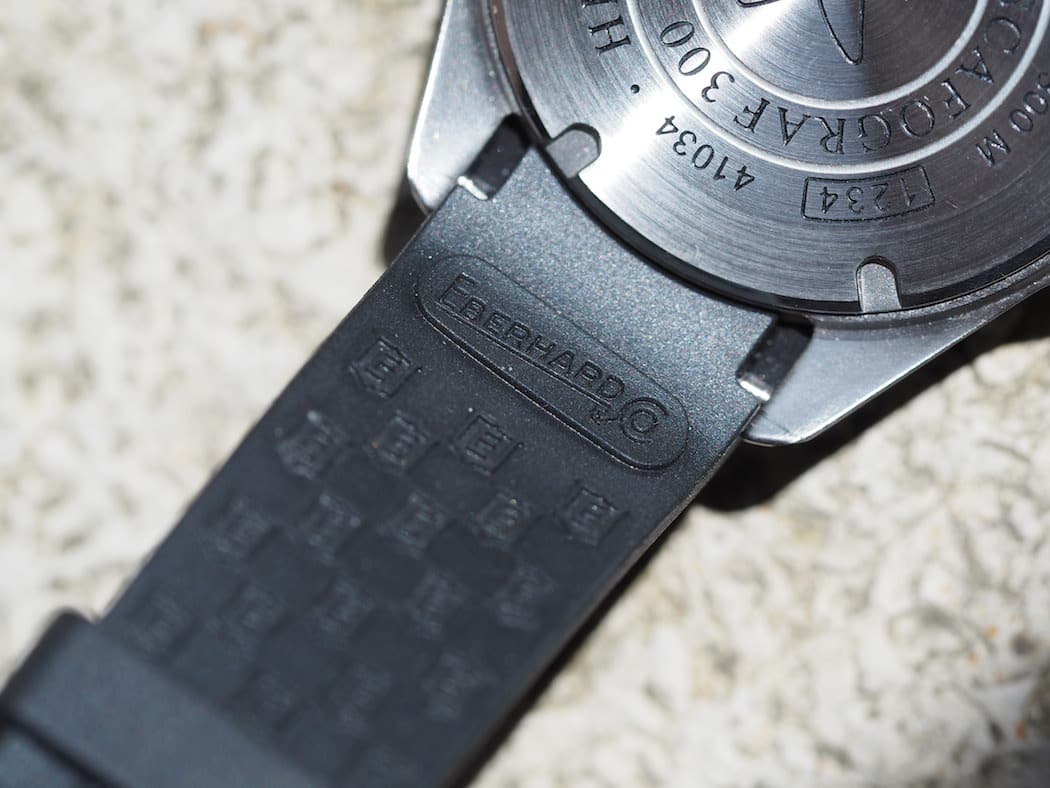
The backside fo the rubber strap on the Scafograf 300 is nicely embossed
With the formalities, now out of the way, let’s get to why I chose to review the Scafograf 300 because, yes, I asked to review it. What struck me about the Eberhard at Basel was that it came off as a very basic, no frills, diver and aside from the helium valve, that’s exactly what it is. In practice, it’s no different than the Seiko Marinemaster I recently reviewed and it even reminds me of Omega Seamasters from 10-15 years ago. So, call me nostalgic or just blame it on me looking for simplicity, but I was darn excited to get my hands on the watch.
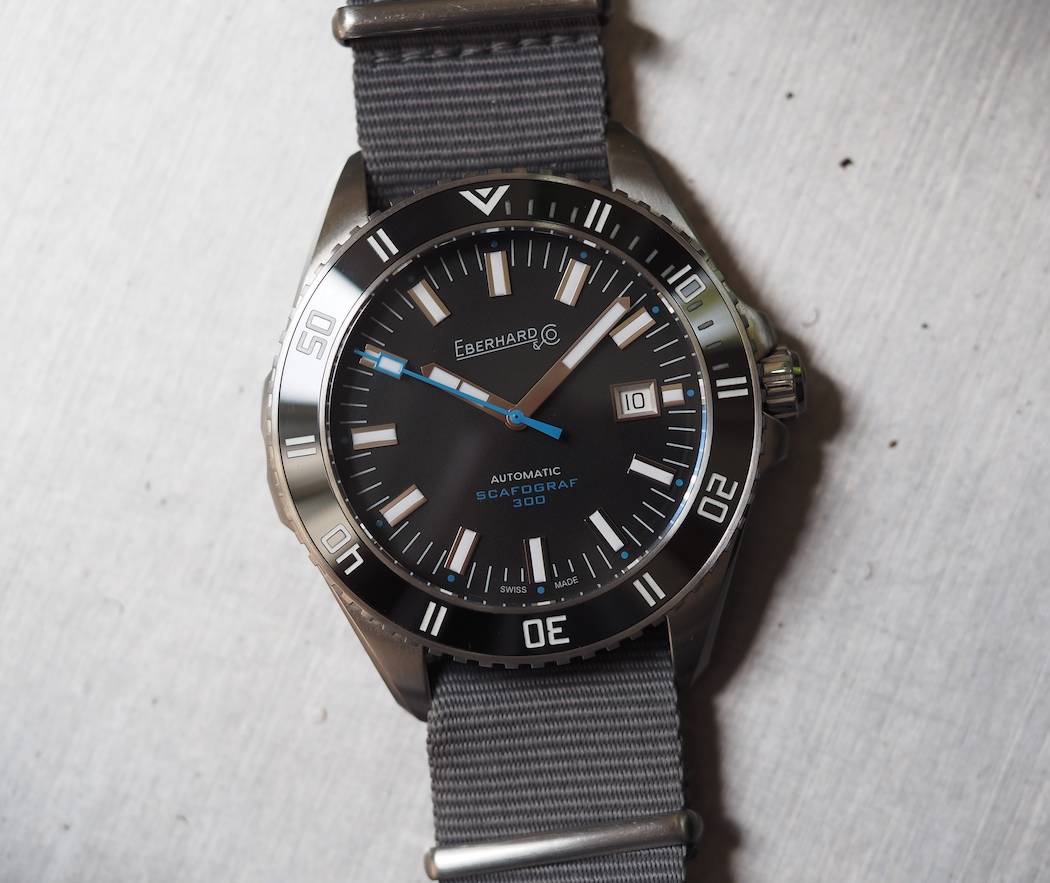
The Eberhard Scafograf 300 did duty on a 22mm NATO strap despite its 21mm lugs
I can’t really comment on the Scafograf 300 packaging as the watch came solo, but I’m sure it’s nice. Still, I attempted to throw the watch on its very nicely made rubber strap and, you guessed it, it was way too big for me. So, it was a wait until returning home to throw it onto a NATO strap. You might notice a little strap overhang because, yes, 21mm is an oddball lug width, but the 22mm strap did the job and I actually think it looked fine. Coming back to the strap, though, it’s a high quality strap (has that lovely vanilla aroma) fitted with an Eberhard logo on the outside and loads of little Eberhard logos on the interior.
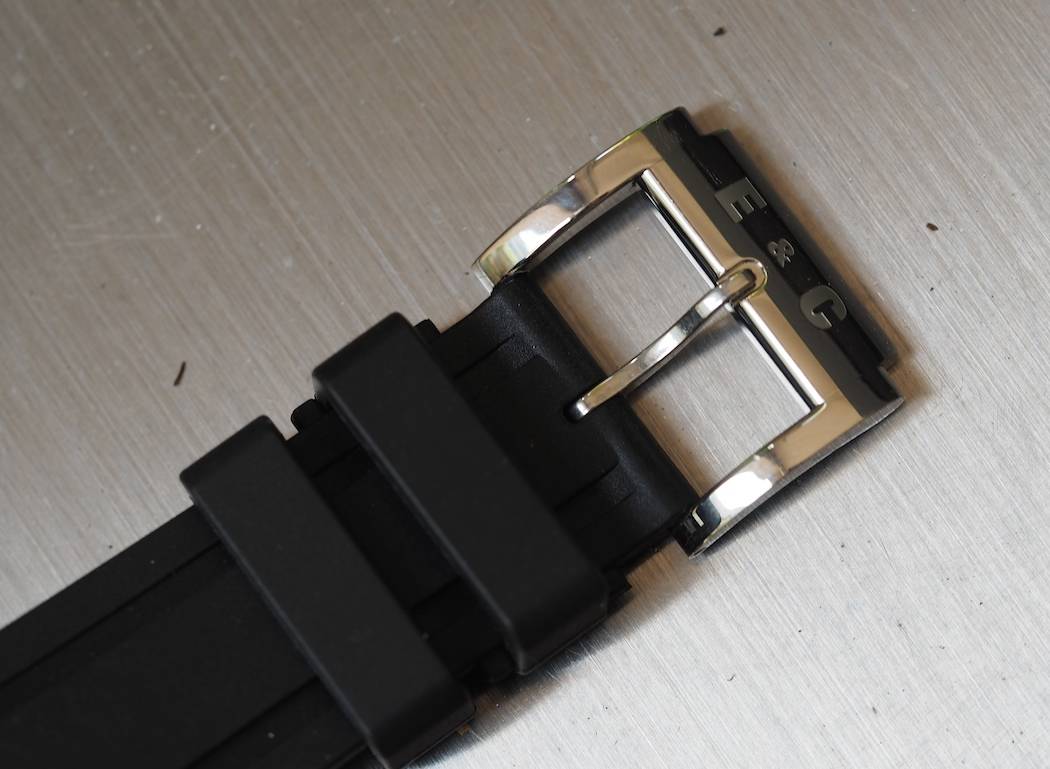
The bold pin buckle found on the Scafograf 300
Interestingly, and perhaps more practically for diving, the watch contains a beautiful signed pin buckle. I like the simplicity, but some may see this as an opportunity for Eberhard to make an upgrade at a later stage considering the watch pricing.
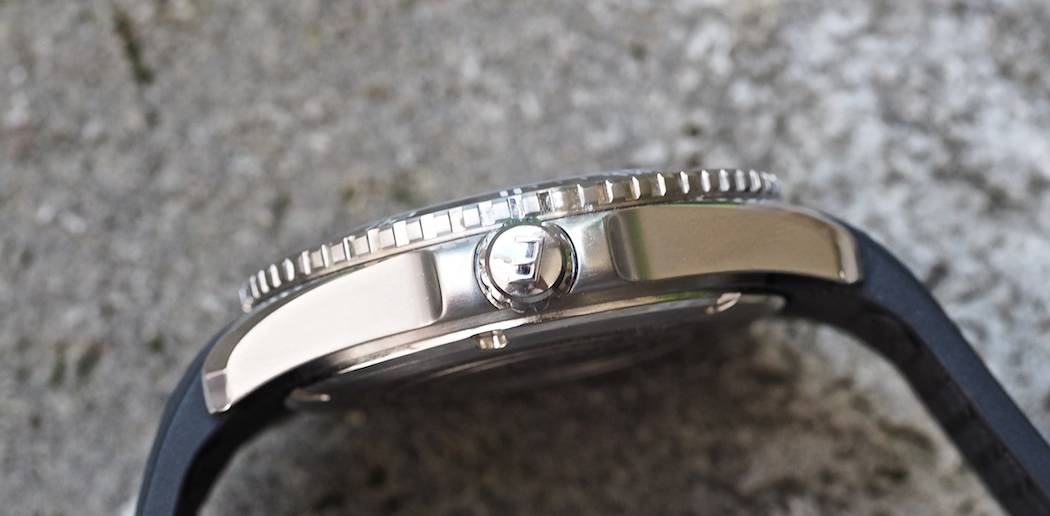
The simple screw-down “E” crown on the Scafograf 300
An Everyday Watch for all Occasions
Once I had the Scafograf 300 on the wrist, the first thing that struck me was just how slim it is and how abnormal that seems to be in today’s day and age of thick diving watches. Over the course of roughly one week of wearing it, it became one of those watches that I rarely noticed while on from an annoyance point of view – it’s seriously comfortable. I also found that despite the large diameter on paper, the watch fit my wrist nicely. Owe this to short lugs that carry on the retro 1960’s diver look of brands such as Eberhard, Omega and Eterna. Also, as you can see from pictures, the crystal is flush mounted with the bezel and tables very gradually to a soft point in the middle. Again, a detail like this came off as oddly simple and yet so pleasing.
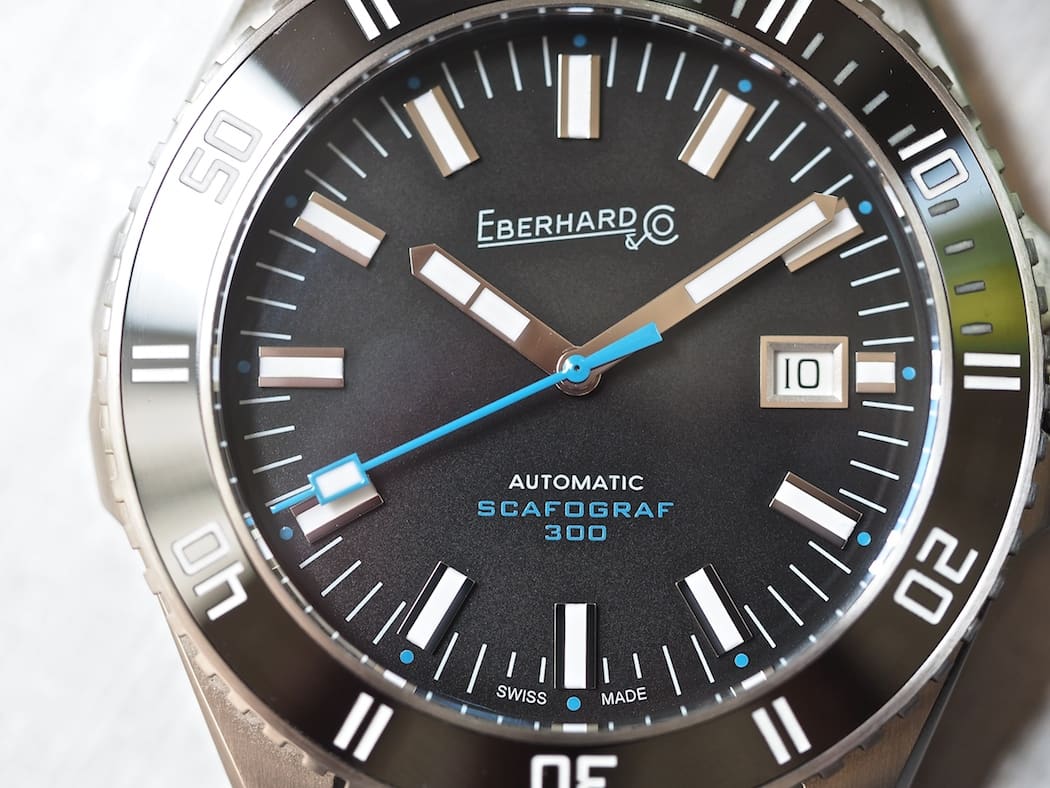
The Eberhard Scafograf 300 dial – showing the date wheel with serif font
A Blend of Retro and Modern
Coming to the dial, the Scafograf 300 exudes legibility. The simple lumed applied indices are bold enough to work in low light conditions but don’t overpower the look of the dial. They’re well-suited to the retro styled hands that are also reminiscent of earlier Scafografs. Note the sweep second hand and its lovely turquoise blue color with a rectangular pip that reminds me of that found on the earlier Zenith El Primero chronographs. The blue, showing more restraint, is only found on the dial stating the model name and in great little dots at each hour. Otherwise, the dial is finished in a stealthy matte black and white printing for the minutes and writing. Regarding the printing, I must say that the “Eberhard & Co.” signature is one of my favorites in the watch world. Otherwise, the face contains a rather unobtrusive and bezeled date window. The numerals on the white date wheel even contain some old-school serif.
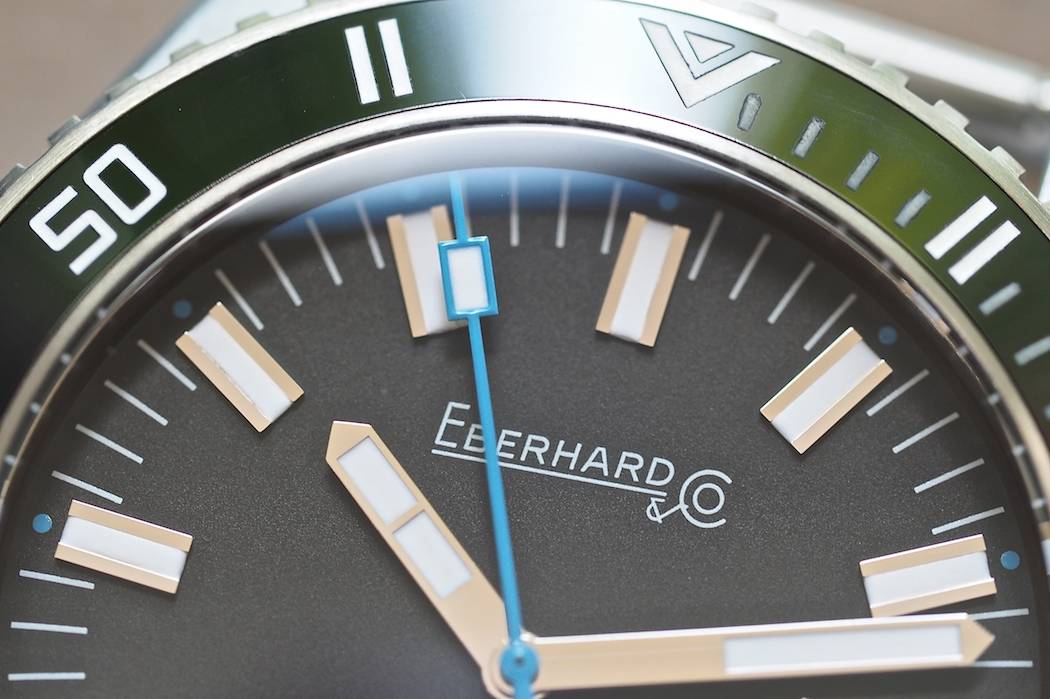
The arrow at 12:00 as well as the minute markers on the bezel through 15 are filled with lume on the Scafograf 300
The bezel on the Scafograf 300 is one of the more noticeable features because it’s ceramic. To be very honest, I don’t get too excited about ceramic bezels, but this one, with its blocky font and nice arrow design at 12:00 looks the part. It’s also not overly shiny, which seemed to be a style found on earlier watches from other brands employing the non-fading material. The bezel has a nice heavy, tactile feel and I like the fact the arrow and first 15 minutes are filled with super luminova. The lume, by the way, is very good. From the side, you can see that the bezel takes a retro stance with its “brick-like” knurling. It fits the watch perfectly and with the ceramic up top, it’s the perfect blend between old and new.
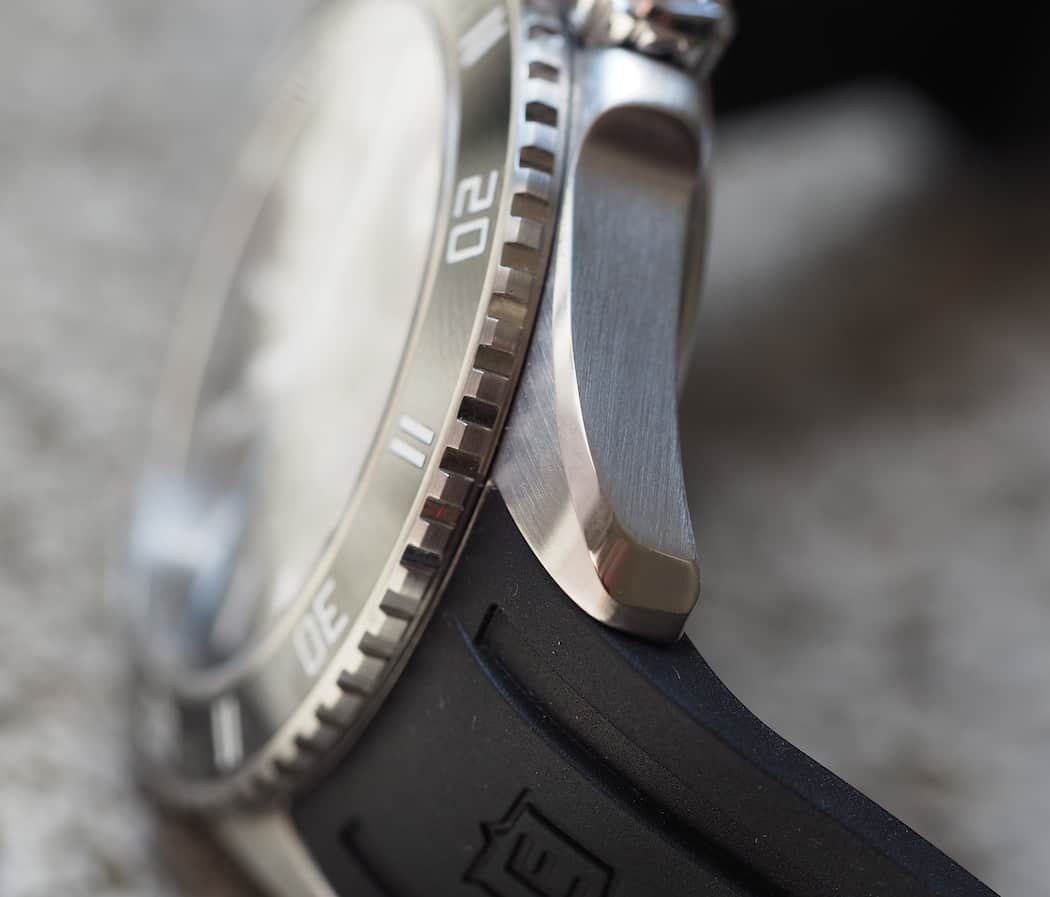
Simple but nice finishing exists on the case of the Scafograf 300
Case-wise, the Scafograf 300 boasts nice, albeit, reasonably basic finishing. It’s a tool watch, so it’s built for durability, but it does contain alternating polished and matte surfaces. The case back, while it’s adorned, is also rather simple with what looks like laser engraving. Frankly, while case backs aren’t a big deal for me, some sort of embossing would be interesting featuring the historical starfish logo. Moving to the crown, we have a signed “E” on the polished piece and that’s definitely in keeping with vintage pieces. Then, to provide symmetry, we see the case jut out slightly at 9:00 and, yep, we find a helium valve.
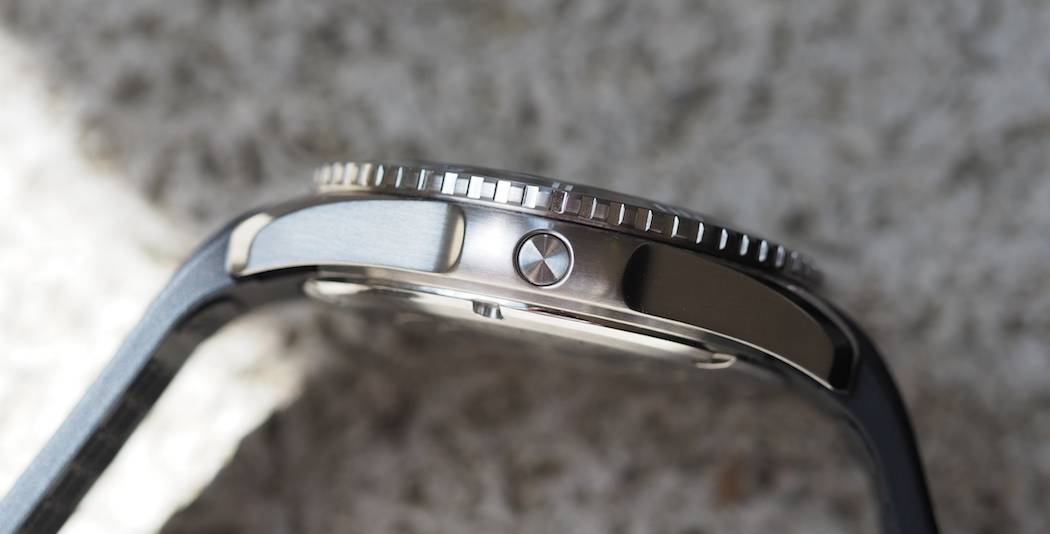
And there it is…the helium valve on the Scafograf 300
The Helium Valve…
Look, I’ll keep this fairly brief because others have opined heavily on the subject, but I don’t understand the need for a helium valve on the Scafograf 300. Sure, perhaps because of the case design, Eberhard felt the need to add this, but it seems superfluous to me when so many other brands are able to pull this off sans the additional portal in the case. Furthermore, the valve adds cost, complexity and, really, who will truly make use of this? Mini-rant over, but I’d vote to drop the valve and reduce the price.
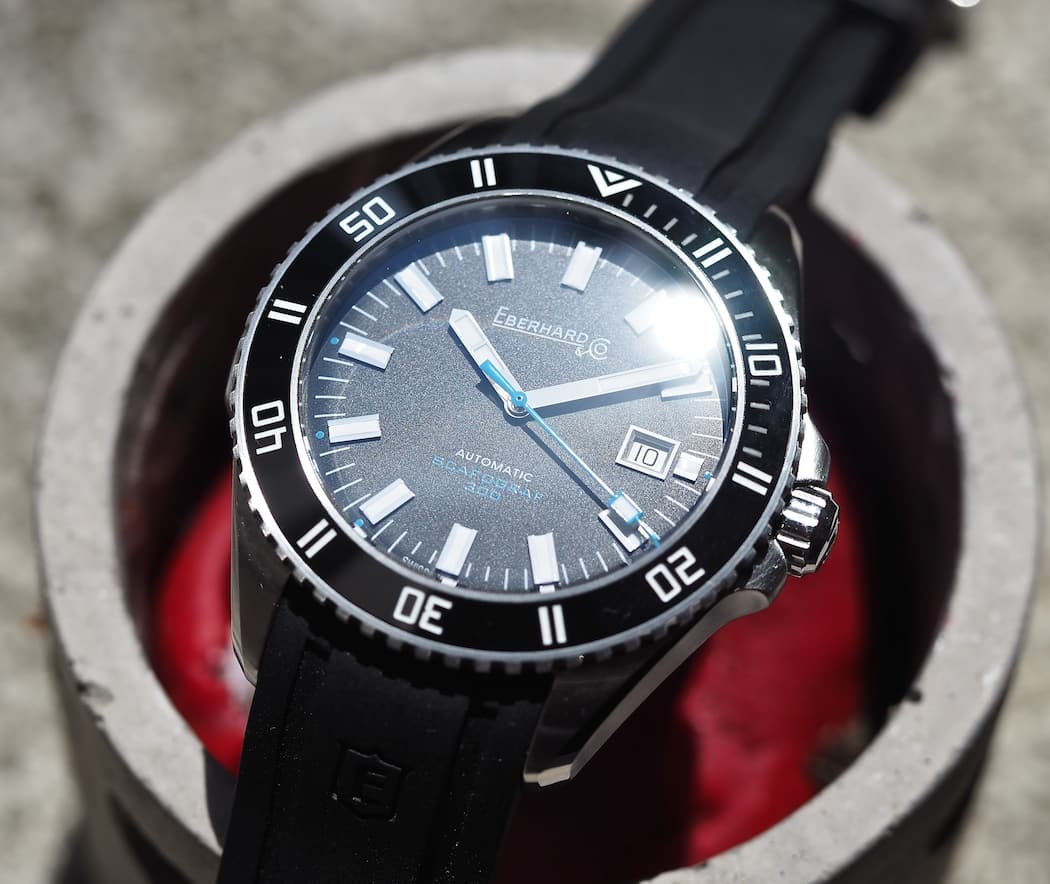
Love that finish on the dial of the Scafograf 300
Movement wise, the use of the ETA 2824-2 isn’t a decision to be chided. In fact, it’s used all over, is easily serviceable and is awfully accurate and reliable. As an example, Tudor employed this movement up until only the last year in its Black Bay series and Pelagos before switching to an in-house caliber. So, no, I have no issues with the movement, but despite using an outside sourced powerplant, note that the Scafograf 300 doesn’t come inexpensively. In Europe, it retails for 2490 Euros on strap and 3070 Euros with bracelet.
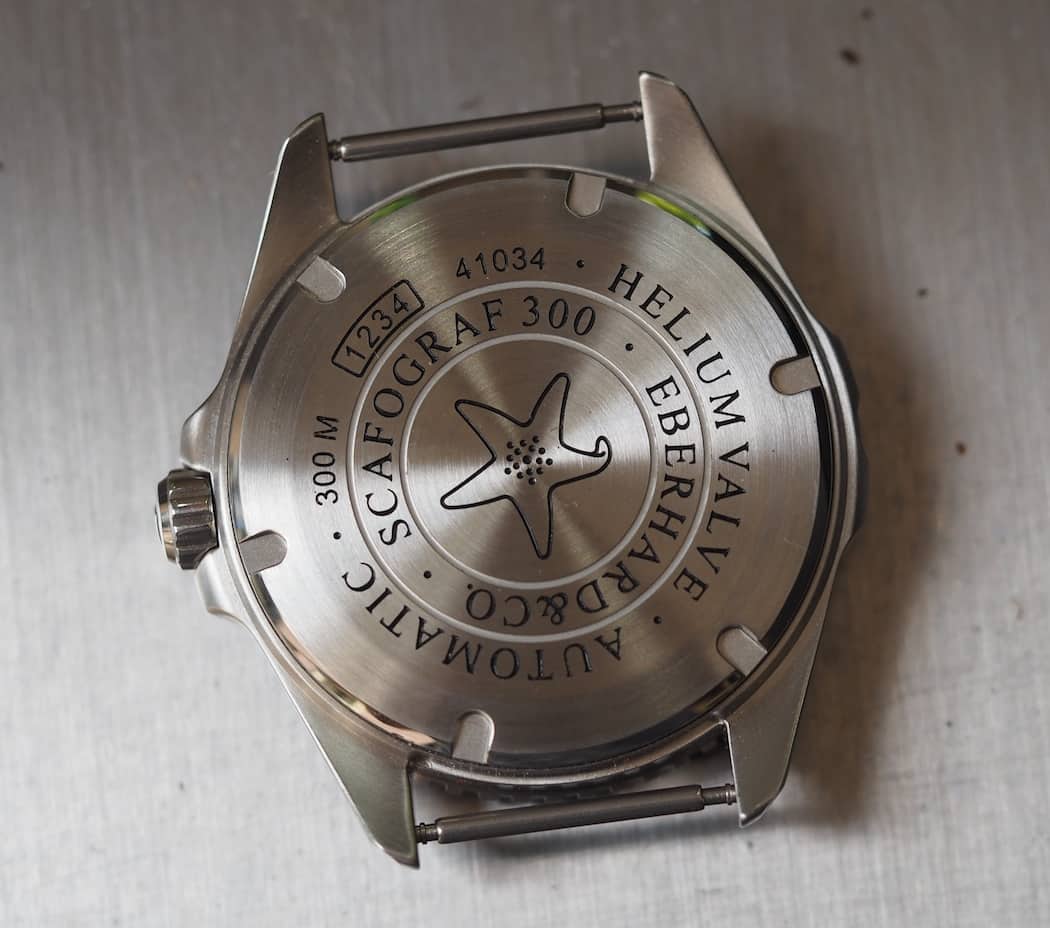
The engraved case back of the Scafograf 300 showing the classic image of the starfish
The Scafograf 300 Owner
So, who should buy the Scafograf 300? The mid-level diver market is crowded. In fact, we discussed this when we reviewed the Seiko Marinemaster, but the Scafograf is somehow a bit different. It’s an oddly appealing watch, despite the high cost of entry and helium valve, because it’s just so simply nice. I can’t overstate how comfortable it was and absolutely appropriate for almost any setting if worn on the bracelet. Plus, Eberhard is a “hot” brand in vintage circles and I find this to be a credible homage that isn’t a direct copy of a previously offered watch. In some ways, I think of this watch as a bit more of a competitor to something like a Doxa, which is, let’s face it, not a watch you’ll see on the wrist of everyone. The brand has a solid history, is on firm footing today, and has a really nice lineup overall.
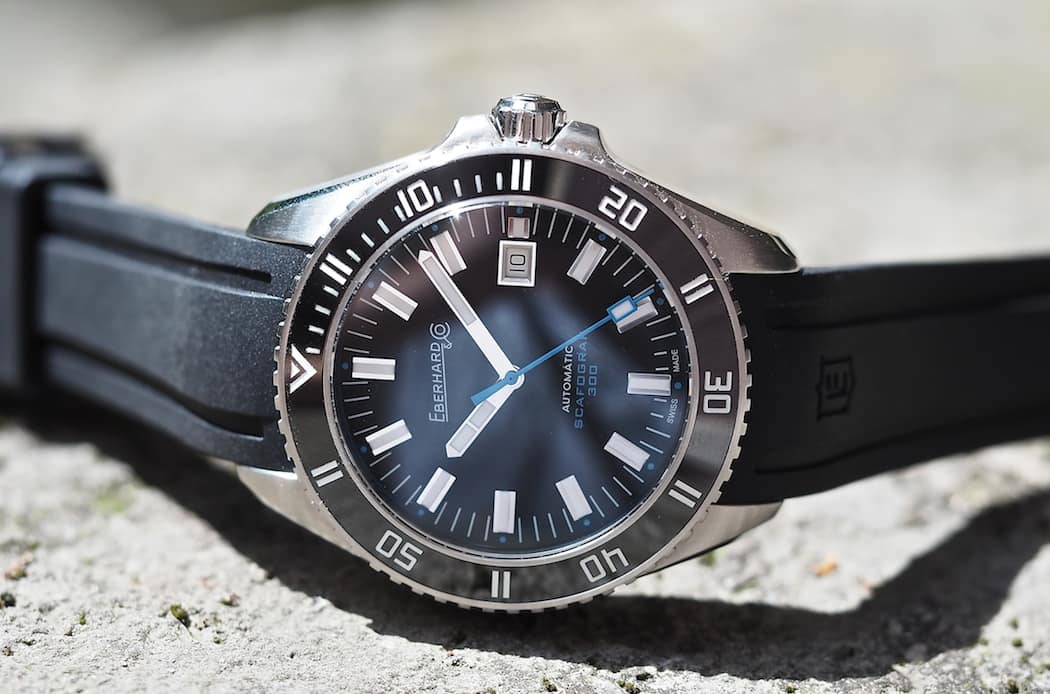
An anti-reflective coating is present on the sapphire crystal of the Scafograf 300
The Scafograf 300, probably much like it was during most of its history, is not a mainstream watch. Sure, it will be cross-shopped in some cases, but I think those who simply want something different than 99% of other dive watch wearers will buy it. If they do make this choice, I think they’ll be satisfied with how fulfilling the watch is as an everyday wearer.
For more information on the Scafograf 300, head to Eberhard’s official page.

















